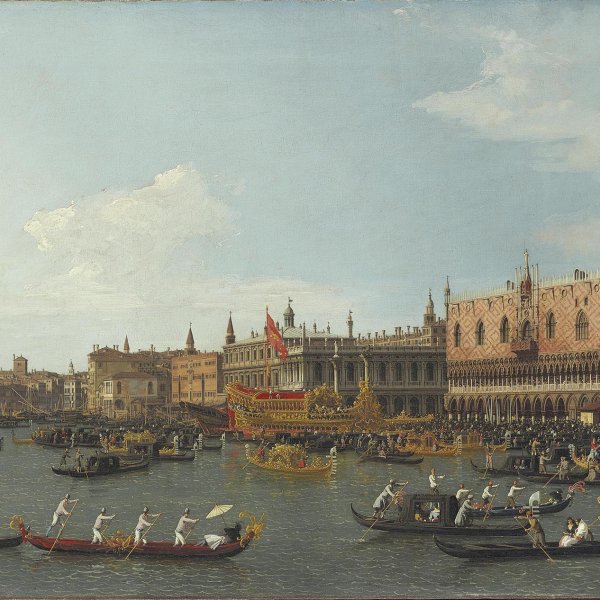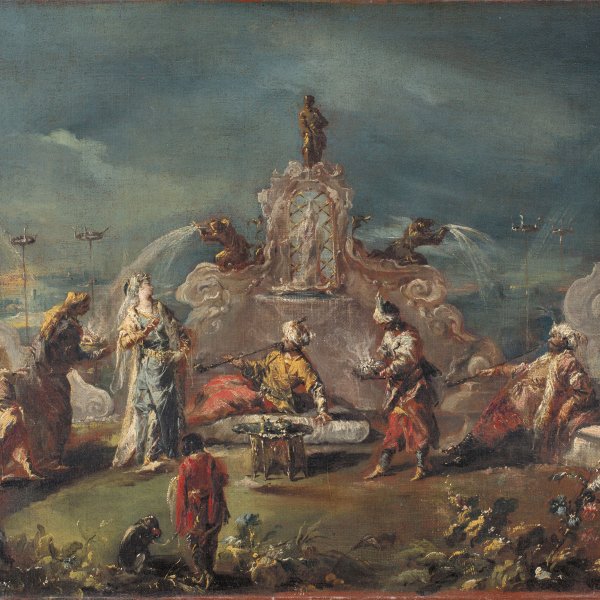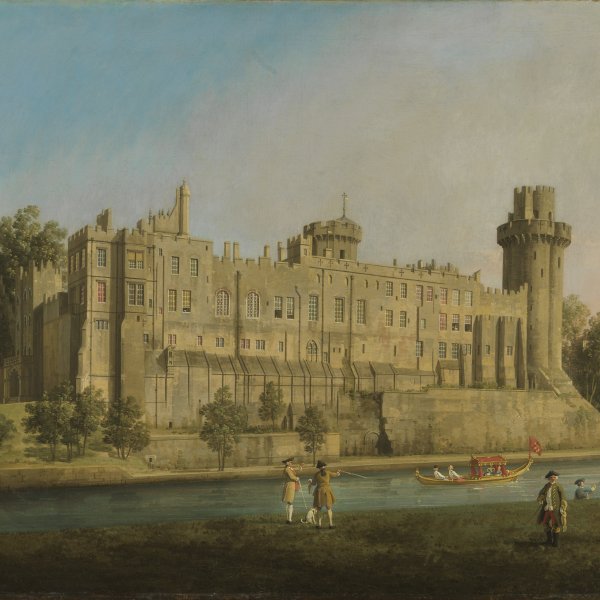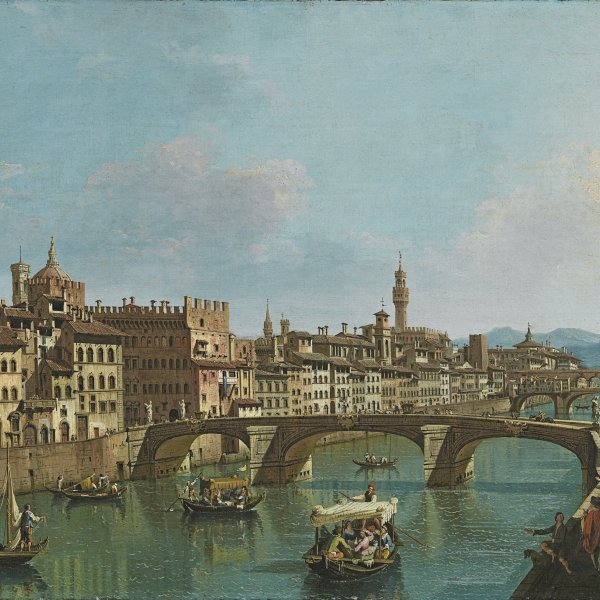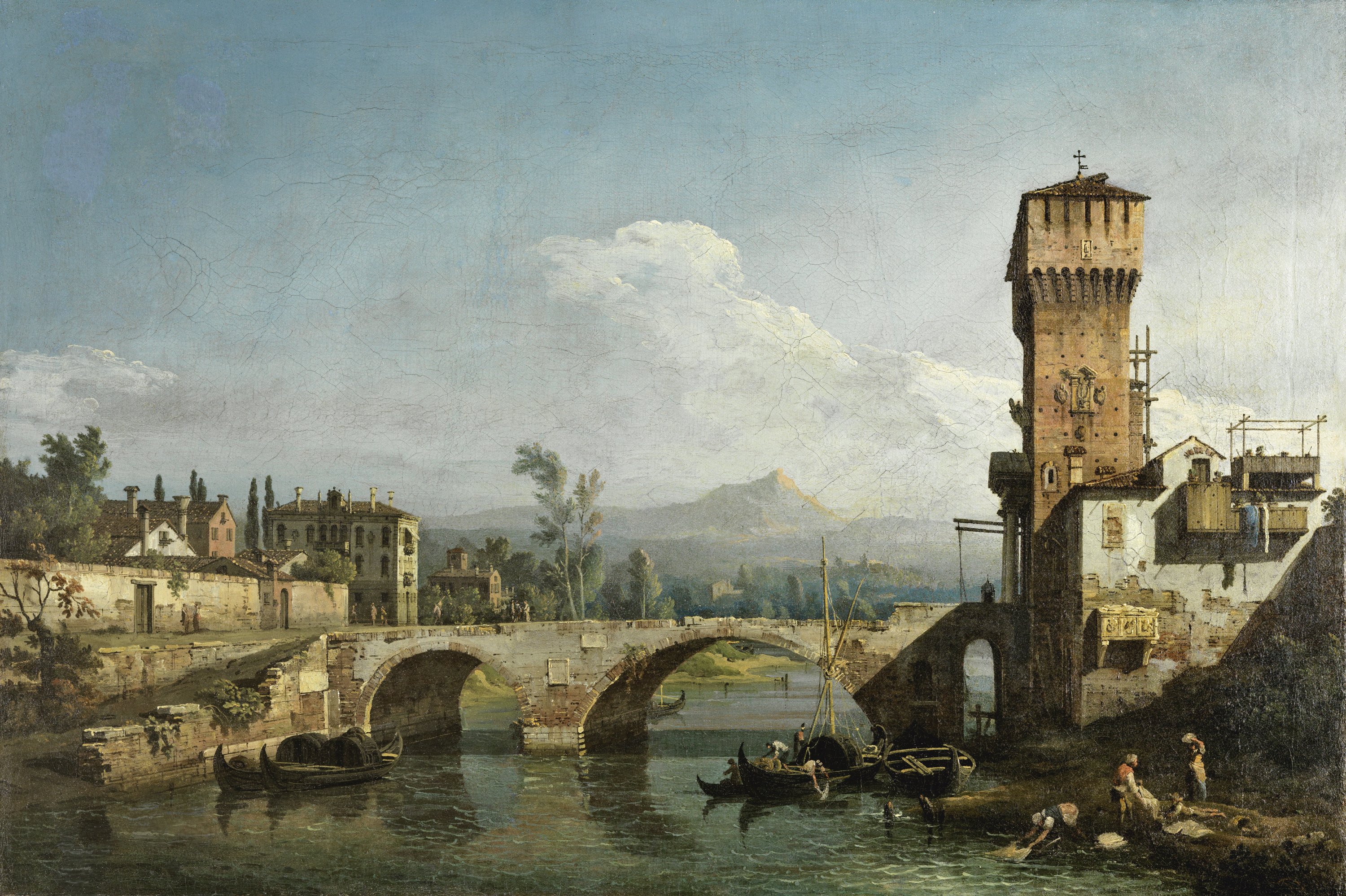Capriccio with a River and Bridge
ca. 1745
Oil on canvas.
48.5 x 73 cm
Museo Nacional Thyssen-Bornemisza, Madrid
Inv. no.
40
(1934.2
)
Room 17
Level 2
Permanent Collection
Bernardo Bellotto, Canaletto’s pupil and nephew, was together with his uncle one of the great painters of urban views. His repertoire of subjects, which was considerably larger than Canaletto’s, encompassed a number of cities such as Lucca, Florence, Rome, Turin and Verona, in addition to his early Venetian views. This list of locations would increase in the late 1750s with his close-up and panoramic views Dresden, Vienna, Munich and Warsaw and his depictions of their principal buildings.
The present painting dates to Bellotto’s early period and is an example of the type of ideal landscape generally described as a Capriccio. In works of this type artists brought together real buildings from different places, changing their location and placing them next to other imaginary ones against a landscape background. In his early works Bellotto’s style was notably close to that of Canaletto.
The present canvas was in the Viennese collection of Camillo Castiglione and was auctioned in Amsterdam in 1925. It entered the UK art market with Thomas Agnew & Sons, where it was to be found in 1926. The canvas was acquired for the Thyssen-Bornemisza collection 1934 and is first mentioned in the literature by Rudolf Heinemann in his entries in the catalogues of the Collection. Pallucchini studied the painting in 1960 and published it in his text on 18th-century Venetian painting.
Traditionally dated to around 1740–42, in recent studies the painting has been given a date of 1745, after Bellotto’s time in Lombary. The traditional title of Paduan Capriccio has also been modified due to the identification of some of the elements and the revised identification of others. For example, the country residence on the left is similar to those on the banks of the Brenta, while the tower was previously identified as the one in Ezzelino, leading to the original date of around 1740 when Bellotto was in Padua. However, these Paduan elements are combined with others suggestive of Venice as well as the misty mountains in the background and an innovative treatment of the tower on the right, which recalls the tower in the principal courtyard of the Castello Sforzesco in Milan. This has suggested that the painting dates from after the artist’s trip to Lombardy. According to Marini the painting also contains compositional elements that Bellotto used in his celebrated view of the Ponte delle Navi in Verona.
The present Capriccio has been related to a drawing attributed to Bellotto in the Boijmans-Van-Beuningen Museum in Rotterdam. In the drawing a bridge spans a canal from one side of the composition to the other, while the right side has a similar building to the one in the Museum’s canvas with a tomb similarly attached to its wall. On the left, however, the drawing includes a city. The banks of the river are different to the present work and Bellotto placed more emphasis on the right bank. These small differences do not, however, affect the overall spirit of the composition and the numerous similarities with the present canvas. According to specialist authors, the drawing in Rotterdam is based on another by Canaletto in the British Royal Collection.
Despite the evident stylistic debt to Canaletto, the painting reveals features typical of Bellotto’s own style such as the detailed description of each of the individual elements and the way they are combined to give a sense of reality to the overall view. The differences with Canaletto also extend to the use of pronounced contrasts between the areas in shadow and those illuminated by the sun. In addition, the figures are taller and less precisely painted, the chromatic range is cooler and the brushstroke more heavily charged.
Mar Borobia
The present painting dates to Bellotto’s early period and is an example of the type of ideal landscape generally described as a Capriccio. In works of this type artists brought together real buildings from different places, changing their location and placing them next to other imaginary ones against a landscape background. In his early works Bellotto’s style was notably close to that of Canaletto.
The present canvas was in the Viennese collection of Camillo Castiglione and was auctioned in Amsterdam in 1925. It entered the UK art market with Thomas Agnew & Sons, where it was to be found in 1926. The canvas was acquired for the Thyssen-Bornemisza collection 1934 and is first mentioned in the literature by Rudolf Heinemann in his entries in the catalogues of the Collection. Pallucchini studied the painting in 1960 and published it in his text on 18th-century Venetian painting.
Traditionally dated to around 1740–42, in recent studies the painting has been given a date of 1745, after Bellotto’s time in Lombary. The traditional title of Paduan Capriccio has also been modified due to the identification of some of the elements and the revised identification of others. For example, the country residence on the left is similar to those on the banks of the Brenta, while the tower was previously identified as the one in Ezzelino, leading to the original date of around 1740 when Bellotto was in Padua. However, these Paduan elements are combined with others suggestive of Venice as well as the misty mountains in the background and an innovative treatment of the tower on the right, which recalls the tower in the principal courtyard of the Castello Sforzesco in Milan. This has suggested that the painting dates from after the artist’s trip to Lombardy. According to Marini the painting also contains compositional elements that Bellotto used in his celebrated view of the Ponte delle Navi in Verona.
The present Capriccio has been related to a drawing attributed to Bellotto in the Boijmans-Van-Beuningen Museum in Rotterdam. In the drawing a bridge spans a canal from one side of the composition to the other, while the right side has a similar building to the one in the Museum’s canvas with a tomb similarly attached to its wall. On the left, however, the drawing includes a city. The banks of the river are different to the present work and Bellotto placed more emphasis on the right bank. These small differences do not, however, affect the overall spirit of the composition and the numerous similarities with the present canvas. According to specialist authors, the drawing in Rotterdam is based on another by Canaletto in the British Royal Collection.
Despite the evident stylistic debt to Canaletto, the painting reveals features typical of Bellotto’s own style such as the detailed description of each of the individual elements and the way they are combined to give a sense of reality to the overall view. The differences with Canaletto also extend to the use of pronounced contrasts between the areas in shadow and those illuminated by the sun. In addition, the figures are taller and less precisely painted, the chromatic range is cooler and the brushstroke more heavily charged.
Mar Borobia





